
By Derek Reinke
Oregon law requires that any person acting in the capacity of an insurance agent, adjuster, or consultant regarding Oregon risks must be licensed to do so by the Insurance Division of the Department of Consumer and Business Services. The Insurance Division may also license a firm or corporation to transact business in any license category and license class or subclass for which that firm or corporation employs an individual licensed for the given category and class. This summary provides detailed information about the distribution throughout the state of individuals and firms licensed to do business in each category, and class or subclass, of insurance business.
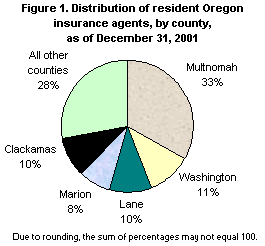 As
of December 31, 2001, there were 47,964 people licensed as Oregon insurance
agents. Of these agents, 19,911 (41 percent) were located in Oregon and
28,503 (59 percent) were located out of state.The reason for the high
number of nonresident agents is that any agent who sells a policy that
includes coverage for an Oregon risk must have an Oregon license. The
total number of licensed agents grew by 17 percent during 2001, with the
nonresident component increasing by 26.9 percent — compared to only
7.6 percent for residents. At least a few insurance agents were licensed
in every county in Oregon, with the number ranging from three in Sherman
County to 6,597 in Multnomah County. Over half of Oregon’s resident
agents were located in the Portland area’s Multnomah, Washington,
and Clackamas counties (see Figure 1).
As
of December 31, 2001, there were 47,964 people licensed as Oregon insurance
agents. Of these agents, 19,911 (41 percent) were located in Oregon and
28,503 (59 percent) were located out of state.The reason for the high
number of nonresident agents is that any agent who sells a policy that
includes coverage for an Oregon risk must have an Oregon license. The
total number of licensed agents grew by 17 percent during 2001, with the
nonresident component increasing by 26.9 percent — compared to only
7.6 percent for residents. At least a few insurance agents were licensed
in every county in Oregon, with the number ranging from three in Sherman
County to 6,597 in Multnomah County. Over half of Oregon’s resident
agents were located in the Portland area’s Multnomah, Washington,
and Clackamas counties (see Figure 1).
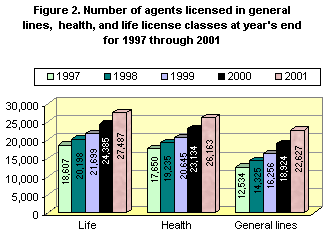 In
the four years ending December 31, 2001, the number of licensed agents
grew 81 percent for the general lines class, 48 percent for the health
class, and 48 percent for the life class (see Figure 2). Stricter enforcement
of nonresident agent licensing requirements contributed to growth in all
three classes. The Insurance Division’s emphasis on licensing customer
service representatives of Property and Casualty agencies also contributed
to the growth in general licenses.
In
the four years ending December 31, 2001, the number of licensed agents
grew 81 percent for the general lines class, 48 percent for the health
class, and 48 percent for the life class (see Figure 2). Stricter enforcement
of nonresident agent licensing requirements contributed to growth in all
three classes. The Insurance Division’s emphasis on licensing customer
service representatives of Property and Casualty agencies also contributed
to the growth in general licenses.
The number of licensees has grown rapidly over the past few years in several subclasses, as the Agent Licensing Section continued efforts to license individuals selling insurance as an adjunct to another line of business. For example, the lender’s property insurance and credit involuntary unemployment insurance subclasses have shown rapid growth since 1997 (see Figure 3). Nearly all of the growth in the lender’s property insurance subclass can be traced to automobile dealerships. The variable annuity subclass has also shown a significant increase, up 59 percent since 1997 (see Figure 4).
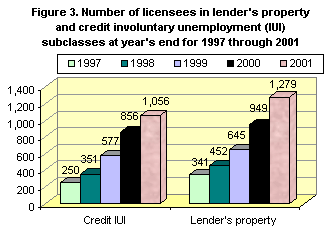 |
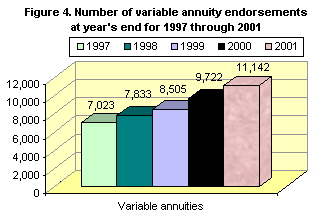 |
At the end of 2001, there were 1,062 independent insurance
adjusters licensed in Oregon. The total number of licensed adjusters grew
6 percent during 2001, with the nonresident component increasing by 10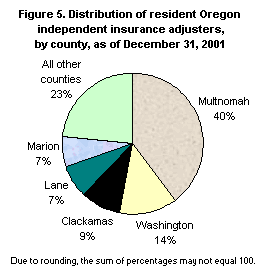 percent
— compared to a 1 percent increase for residents. Forty-three percent
of adjusters were Oregon residents and 57 percent were nonresidents. Multnomah
County, with 180 adjusters, accounted for 40 percent of all resident adjusters.
The top five counties accounted for 77 percent of all resident adjusters
(see Figure 5). Eight of Oregon’s 36 counties had no adjusters and
another seven had only one apiece. The adjuster category includes only
two license classes — health and general lines — and no subclasses
or endorsements. Of all adjusters licensed as of December 31, 2001, only
23 were licensed for health lines. The majority of agents were licensed
for general lines only.
percent
— compared to a 1 percent increase for residents. Forty-three percent
of adjusters were Oregon residents and 57 percent were nonresidents. Multnomah
County, with 180 adjusters, accounted for 40 percent of all resident adjusters.
The top five counties accounted for 77 percent of all resident adjusters
(see Figure 5). Eight of Oregon’s 36 counties had no adjusters and
another seven had only one apiece. The adjuster category includes only
two license classes — health and general lines — and no subclasses
or endorsements. Of all adjusters licensed as of December 31, 2001, only
23 were licensed for health lines. The majority of agents were licensed
for general lines only.
There were 429 licensed consultants at the end of 2001 — up 13 percent
from a year earlier. Multnomah County, with 186 consultants, accounted
for 43 percent of all consultants during 2001 (see Figure 6). Eleven counties
had no consultants and six others had only one apiece. Only 11 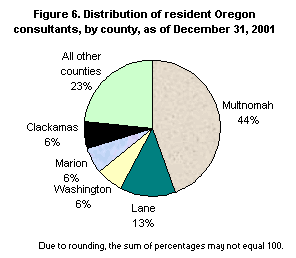 consultants
were nonresidents. All three license classes — life, health, and
general lines — were available to consultants; but there were no
subclasses or endorsements for consultants. At the end of 2001, there
were 335 consultants licensed for life, 344 for health, and 170 for general
lines. Most consultants were licensed in multiple classes. Three hundred
thirty (77 percent) were licensed for both life and health. Of those,
87 were also licensed for general lines.
consultants
were nonresidents. All three license classes — life, health, and
general lines — were available to consultants; but there were no
subclasses or endorsements for consultants. At the end of 2001, there
were 335 consultants licensed for life, 344 for health, and 170 for general
lines. Most consultants were licensed in multiple classes. Three hundred
thirty (77 percent) were licensed for both life and health. Of those,
87 were also licensed for general lines.
At the end of 2001 there were 6,609 firms licensed in Oregon as insurance
agencies, of which 41 percent were located in Oregon and 59 percent were
located out of state. Every county had at least one agency, with the number
ranging from one for Sherman County to 692 for Multnomah County. The ratio
of agents to agencies tends to decline as population density declines.
Multnomah County had an  agent-to-agency
ratio of 9.5. Lane, Washington, Marion, and Clackamas counties combined
had 40 percent of resident agencies (see Figure 7) and a ratio of 7.3.
All other counties combined had a ratio of 6.0. Statewide, the agent-to-agency
ratio was 7.4 during 2001.
agent-to-agency
ratio of 9.5. Lane, Washington, Marion, and Clackamas counties combined
had 40 percent of resident agencies (see Figure 7) and a ratio of 7.3.
All other counties combined had a ratio of 6.0. Statewide, the agent-to-agency
ratio was 7.4 during 2001.
The number of firms licensed for general lines grew by 2 percent in 2001, while the number licensed for life and the number licensed for health were both up 5 percent. The number of agencies licensed for lender’s property insurance increased from 171 to 192. Nearly all of the new firms in this subclass were automobile dealerships. Credit involuntary unemployment insurance was a new subclass in 1995. The number of licensed firms in this subclass grew quickly for the first few years, but the number appears to have leveled off at around 51 (see Figure 8).
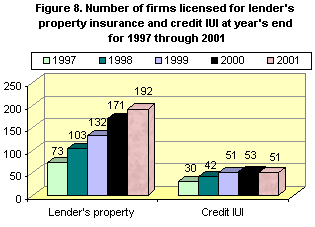 |
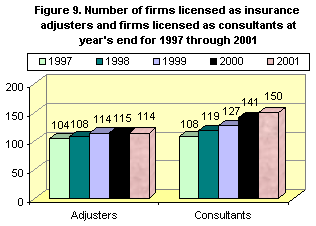 |
The number of licensed independent insurance adjuster firms in Oregon declined just slightly in 2001, from 115 to 114 (see Figure 9). Seventy-five of the 114 firms were resident firms.
Only 18 of Oregon’s 36 counties had firms licensed as adjusters as of December 31, 2001, and eight of those had only one apiece. Multnomah County had 23, while Washington and Marion counties had 11 and 10, respectively (see Figure 10). Adjusters may only be licensed for health or general lines classes of insurance. Of the 114 firms licensed as adjusters in Oregon, 112 were licensed for general lines and two for health.
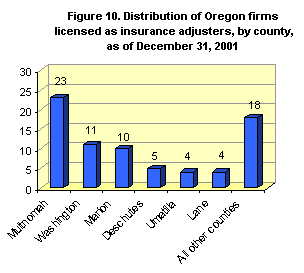 |
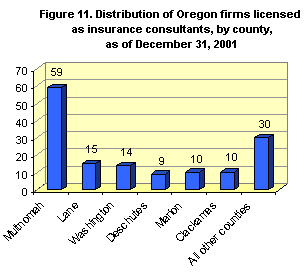 |
At the end of 2001, there were 150 firms licensed as consultants — an increase of 6.4 percent over the 141 a year earlier (see Figure 9). Only three such firms were located out of state, while 147 were located in Oregon. A count of these firms by county of location shows the highest concentration in Multnomah County (59, or 40 percent of the resident total). Lane and Washington counties were a distant second and third with 15 and 14, respectively (see Figure 11). This count also reveals that only 21 of the 36 Oregon counties serve as the home location for a firm with a consultant license. Most of the consultant firms were licensed in more than one of the three allowable classes — life, health, and general lines. Specifically, 61 were licensed for all three and another 71 were licensed for life and health only.
Licensing Requirements
An applicant for a license as an agent, adjuster, or consultant must provide the Insurance Division’s Licensing Section with information about his or her occupational background, insurance experience, any criminal convictions or indictments, judgements against the applicant of fraud, previously suspended or revoked occupational or professional licenses, and debts claimed against the applicant by insurers or agents. The applicant must also state the portion of time to be devoted to the insurance business, all business addresses and assumed business names to be used, and class or classes of insurance business to be transacted under the license. If the applicant is a firm or corporation, the applicant must also provide names of all members, officers, and directors. A corporation must also state the name of each stockholder who owns more than 10 percent of any equity security and the name of each individual who will transact business under the license. Preexamination training is required of resident applicants for general lines, life, and health licenses. Some applicants may be exempt from this requirement if they have specific insurance experience or an industry-related designation.
The Insurance Division may issue a resident license to a person who is an Oregon resident or who, if not a resident, has a place of business in Oregon. The division may issue a nonresident license to a person who is not a resident of Oregon and is licensed in another state. Under reciprocal agreements with other states and Canadian provinces, the department may waive, for a nonresident applicant, any of Oregon’s licensing requirements certified to have been met in the applicant’s home state or province. Original licenses are valid for two years and each renewal is valid for two years. The fee for an original applicant is $30 and the fee for each license category is $45. As a requirement for renewal, an insurance agent licensed for life, health, or general lines must complete at least 44 hours of continuing education for each two year renewal period for the first six years and 12 hours per year after that. The requirement is only 24 hours in any two-year period for those with a Chartered Property and Casualty Underwriter (CPCU) or Chartered Life Underwriter (CLU) designation.
Table A1. Number of Agents
Table A2. Number of Adjusters
Table A3. Number of Consultants
Table A4. Agent License Classes by County
Table A5. Adjuster and Consultant License Classes by County
Table A6. License Class Trends
Table A7. Agent License Class Combinations
Table A8. Adjuster License Class Combinations
Table A9. Consultant License Class Combinations
Table B1. Number of Agencies
Table B2. Number of Adjuster Firms
Table B3. Number of Consultant Firms
Table B4. Agency License Classes, Subclasses, and Endorsements
Table B5. Adjuster and Consultant License Classes for Firms by County
Table B6. License Class Trends for Firms
Table B7. Agency License Class Combinations
Table B8. Adjuster License Class Combinations for Firms
Table B9. Consultant License Class Combinations for Firm
All Tables
DCBS Public Home Page | IMD Home Page | Site Search Engine |
If you have questions about the information contained in this document please contact by e-mail or phone: Derek Reinke, Research Analyst, Research & Analysis Section, Information Management Division (503) 947-7338
This document was originally published in September 2002.
In compliance with the Americans with Disabilities Act
(ADA), this publication is available in
alternative formats by calling (503) 378-4100 (V/TTY).
The information in IMD publications is in the public domain and may be reprinted without permission.